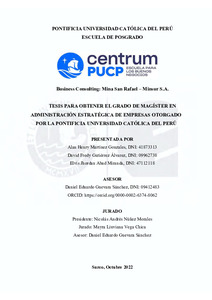| dc.contributor.advisor | Guevara Sanchez, Daniel Eduardo | |
| dc.contributor.author | Martínez Gonzales, Alan Henry | |
| dc.contributor.author | Gutiérrez Álvarez, David Fredy | |
| dc.contributor.author | Abad Miranda, Elvis Jhordan | |
| dc.date.accessioned | 2022-11-05T15:51:06Z | |
| dc.date.available | 2022-11-05T15:51:06Z | |
| dc.date.created | 2022 | |
| dc.date.issued | 2022-11-05 | |
| dc.identifier.uri | http://hdl.handle.net/20.500.12404/23704 | |
| dc.description.abstract | La Unidad Minera San Rafael presenta actualmente una problemática con impacto
económico, social y ambiental relacionada con el aumento en la generación de sus residuos
sólidos domésticos e industriales. El propósito de la presente consultoría fue presentar una
propuesta de solución para esa problemática que permita optimizar la gestión de sus residuos
sólidos para reducir ese aumento desproporcionado. Para ello, con el apoyo en el acceso a la
información de la empresa, se tomó conocimiento de la magnitud del incremento en la
generación de residuos, su caracterización y el aumento en la inversión económica en la
disposición de residuos industriales y domésticos. Luego, se realizó un mapeo de la actual
gestión de residuos, seguido de un análisis de oportunidades de mejora y de un desarrollo de
la priorización de dichas oportunidades que pueden ser abordadas en función del esfuerzo e
impacto que conlleven su implementación. Cada oportunidad priorizada fue estudiada
exhaustivamente a partir de un análisis de causa raíz con participación de los líderes de la
Unidad Minera San Rafael. Así mismo, se consultaron a profesionales de otras unidades
mineras que tuvieron la experticia afrontando procesos de mejora de gestión de residuos. El
punto de partida fue el establecimiento de hipótesis de las causas que estaban generando el
problema, en base a la opinión de los participantes y un análisis de Pareto se definieron las
hipótesis principales (20% de las hipótesis que de ser abordadas solucionan el 80% del
problema). Una vez identificadas las principales hipótesis, se sometió cada una a un análisis
de causa raíz a través de las herramientas del Diagrama de Ishikawa y Cinco Por Qués e
identificadas las causas raíz, junto con los participantes se desarrolló un plan de
implementación táctico, en las que se plasmaron acciones y compromisos (responsables y
fechas). De igual manera, se desarrolló un programa de seguimiento a los acuerdos
establecidos y confirmaciones de rol en campo para evaluar el impacto positivo de la
implementación. | es_ES |
| dc.description.abstract | San Rafael Mining Unit currently presents a problem with an economic, social and
environmental impact related to the increase in the generation of its domestic and industrial
solid waste. The purpose of this consultancy was to present a solution proposal for this
problem that allows optimizing the management of its solid waste, to reduce this
disproportionate increase. To do this, with the support through access to company
information, the magnitude of the increase in waste generation, its characterization and the
increase in economic investment in the disposal of industrial and domestic waste were
learned. Then, a mapping of the current waste management was carried out, followed by an
analysis of opportunities for improvement and a development of the prioritization of said
opportunities that can be addressed based on the effort and impact that their implementation
entails. Each prioritized opportunity was thoroughly analyzed based on a root cause analysis
with the participation of the leaders of San Rafael Mining Unit. Likewise, professionals from
other mining units who had expertise in dealing with waste management improvement
processes were consulted. The starting point was the establishment of hypotheses of the
causes that were found, based on the opinion of the participants and a Pareto analysis; the
main hypotheses were defined (20% of the hypotheses that, if addressed, would solve 80% of
the problem). Once the main hypotheses were identified, each one was studied closely using a
root cause analysis through the Lean Ishikawa and Five Whys tools and the root causes were
identified, together with the participants, a tactical implementation plan was developed, in
which actions and commitments (people responsible and dates) were scheduled. Likewise, a
follow-up program was developed for the established agreements and role confirmations in
the field to evaluate the positive impact of the implementation. | es_ES |
| dc.language.iso | spa | es_ES |
| dc.publisher | Pontificia Universidad Católica del Perú | es_ES |
| dc.rights | info:eu-repo/semantics/openAccess | es_ES |
| dc.rights.uri | http://creativecommons.org/licenses/by-nc-nd/2.5/pe/ | * |
| dc.subject | Industria minera--Perú | es_ES |
| dc.subject | Consultores de empresas--Planificación estratégica | es_ES |
| dc.subject | Desarrollo sostenible | es_ES |
| dc.subject | Sostenibilidad empresarial | es_ES |
| dc.subject | Responsabilidad social | es_ES |
| dc.title | Business consulting: Mina San Rafael – Minsur S.A. | es_ES |
| dc.type | info:eu-repo/semantics/masterThesis | es_ES |
| thesis.degree.name | Maestro en Administración Estratégica de Empresas | es_ES |
| thesis.degree.level | Maestría | es_ES |
| thesis.degree.grantor | Pontificia Universidad Católica del Perú. CENTRUM | es_ES |
| thesis.degree.discipline | Administración Estratégica de Empresas | es_ES |
| renati.advisor.dni | 09412483 | |
| renati.advisor.orcid | https://orcid.org/0000-0002-6374-8062 | es_ES |
| renati.author.dni | 41873313 | |
| renati.author.dni | 09962738 | |
| renati.author.dni | 47112118 | |
| renati.discipline | 413307 | es_ES |
| renati.juror | Nicolás Andrés Nuñez Morales | es_ES |
| renati.juror | Mayra Liuviana Vega Chica | es_ES |
| renati.juror | Daniel Eduardo Guevara Sanchez | es_ES |
| renati.level | https://purl.org/pe-repo/renati/level#maestro | es_ES |
| renati.type | https://purl.org/pe-repo/renati/type#tesis | es_ES |
| dc.publisher.country | PE | es_ES |
| dc.subject.ocde | https://purl.org/pe-repo/ocde/ford#5.02.04 | es_ES |






